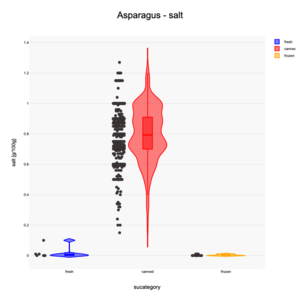Difference between revisions of "Category/Vegetables/Asparagus"
| Line 216: | Line 216: | ||
|0.01 | |0.01 | ||
|0.1 | |0.1 | ||
| − | + | |0.025 | |
|- | |- | ||
|Fruit (%) | |Fruit (%) | ||
Revision as of 10:17, 30 September 2024
The category Asparagus is a perennial flowering plant species in the genus Asparagus native to Eurasia. Widely cultivated as a vegetable crop, its young shoots are used as a spring vegetable.
Super-categories
The super (parent) categories of Asparagus are:
- Vegetable rods;
- etc.
Sub-categories
These subcategories are orthogonal: a product can be assigned one or more of the subcategories.
By type
By presentation
- Canned asparagus for Asparagus in glass pots and cans;
- Fresh asparagus for Asparagus raw in "bottes";
- Frozen asparagus for Asparagus found in the frozen aisles;
By size
By treatment
By origin
- Austria
- France
- Germany
- Italy
- Netherlands
- Spain
- United Kingdom
Related categories
The ingredient Asparagus occurs in some 390 categories. Several of these categories highlight Asparagus:
- Prepared asparagus - for products where other ingredients have been added;
- Asparagus soups - for reheatable and dried soups and asparagus cream soups;
Ingredients
Canned Asparagus
Required ingredients
The following single ingredient is required for products in this category:
Optional ingredients
- Salt - Most Canned Asparagus have salt added.
- Antioxidant;
Disallowed ingredients
Fresh Asparagus
Required ingredients
The following single ingredient is required for products in this category:
Depending on the type subcategory this can be green, violet or white asparagus.
Optional ingredients
none
Disallowed ingredients
everything else
Production process/labels
not yet looked at
Nutritional information
Canned asparagus
| min | 25% | med | 75% | max | upper | |
|---|---|---|---|---|---|---|
| Energy (kJ/100g) | 33 | 72 | 127 | |||
| Fat (%) | 0 | 0 | 0.5 | |||
| Saturated fat (%) | 0 | 0.1 | 0.107 | |||
| Carbohydrates (%) | 0.7 | 1.9 | 4,7 | |||
| Sugars (%) | 0 | 1.1 | 3.5 | |||
| Fiber (%) | 0 | 1.4 | 3.9 | |||
| Proteins (%) | 0.2 | 1.3 | 3.4 | |||
| Salt (%) | 0.15 | 0.7 | 0.79 | 0.91 | 1.27 | 1.2 |
Fresh asparagus
| min | 25% | med | 75% | max | upper | |
|---|---|---|---|---|---|---|
| Energy (kJ/100g) | 79 | 105 | 117 | |||
| Fat (%) | 0 | 0.2 | 0.6 | |||
| Saturated fat (%) | 0 | 0.1 | 0.107 | |||
| Carbohydrates (%) | 0.95 | 3.5 | 3.96 | |||
| Sugars (%) | 0.1 | 1.8 | 2.2 | |||
| Fiber (%) | 1 | 1.7 | 2.09 | |||
| Proteins (%) | 1 | 2.2 | 3.4 | |||
| Salt (%) | 0 | 0 | 0.005 | 0.01 | 0.1 | 0.025 |
| Fruit (%) | 100 |
Frozen asparagus
| min | 10% | 25% | med | 75% | 90% | max | ||
|---|---|---|---|---|---|---|---|---|
| Energy (kJ/100g) | 88 | 88 | 118 | 130 | 130 | |||
| Fat (%) | 0 | 0 | 0.2 | 0.7 | 1.0 | |||
| Saturated fat (%) | 0 | 0 | 0.1 | 0.1 | 0.2 | |||
| Carbohydrates (%) | 1.7 | 2 | 3.8 | 4.3 | 4.8 | |||
| Sugars (%) | 0 | 0.3 | 1.3 | 1.9 | 2.53 | |||
| Fiber (%) | 1 | 1.2 | 1.5 | 2.1 | 2.1 | |||
| Proteins (%) | 1 | 1.7 | 2.6 | 3.2 | 3.2 | |||
| Salt (%) | 0 | 0 | 0 | 0 | 0.007 | 0.011 | 0.011 | 0.02 |
| Fruit (%) | 100 |
Comparing categories
Salt level
The figure shows the violin plots and data of three asparagus subcategories. For the fresh and frozen subcategories there is not much data. However for the Canned Asparagus there is a lot of data. It is clear that salt has been added for all of the products. The box-plot also allows to identify the outlier limits (upper and lower) for each category.
Quality Monitoring
- Errors
- Single ingredient check:
- Fresh asparagus should only contain the ingredient Asparagus;
- Frozen asparagus should only contain the ingredient Asparagus;
- Opposites:
- Canned asparagus, Frozen asparagus and Fresh asparagus should not be assigned simultaneously;
- Green asparagus, Purple asparagus and White asparagus should not be assigned simultaneously;
- Nutritional values envelope - none defined yet;
Last cleanup by hand on 28 sep 2024.
Sales format
Asparagus is sold by:
- package - for frozen Asparagus, for pots/tins or pre-packed in the vegetables aisles;
- weight - in the bulk vegetable aisles;
Issues
none
